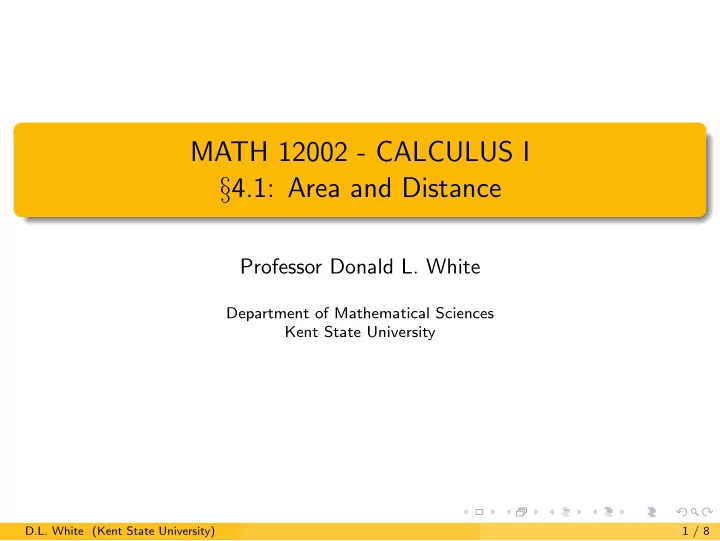

MATH 12002 - CALCULUS I § 4.1: Area and Distance Professor Donald L. White Department of Mathematical Sciences Kent State University D.L. White (Kent State University) 1 / 8
The Area and Distance Problems Integral calculus is motivated in part by two problems: The Area Problem: How do we compute the area of an arbitrary region in the plane, or more specifically, how do we compute the area of a region bounded by the graphs of functions? The Distance Problem: Given a velocity function v ( t ), how do we determine the displacement or distance travelled on a time interval? These problems may not seem related, but they are nearly identical. D.L. White (Kent State University) 2 / 8
Constant Velocity Recall that if velocity is constant, then distance is rate times time. Thus if the velocity function is v ( t ) = r , where r a constant, then on the time interval from t = a to t = b , distance is r ( b − a ). Graphing velocity v as a function of time t , we have: v ✻ b − a r r ✲ t a b The height of the rectangle is r and the width of the rectangle is b − a . Hence the area of the rectangle is r ( b − a ). Therefore, if velocity is constant on the interval from t = a to t = b , then distance travelled is equal to the area of the region bounded by the graph of v ( t ), the t -axis, and the lines t = a and t = b ; or, distance travelled equals the area under the graph of v ( t ). D.L. White (Kent State University) 3 / 8
General Distance and Area Computing areas of rectangles and computing distance when velocity is constant are really the same computation. What about areas of regions whose boundaries are not straight lines, or distance when the velocity is not constant? Recall the Velocity Problem and Tangent Problem we started with: Given a position function s ( t ), we could compute average velocity over a time interval or the slope of a secant line to the graph of s ( t ). To compute instantaneous velocity or the slope of a tangent line, we had to take a limit as the length of the time interval approached zero. D.L. White (Kent State University) 4 / 8
General Distance and Area In order to compute areas of more general regions or displacements when the velocity is not constant, we need a similar procedure. The general idea is as follows: AREA: Approximate the region under the graph of a function by rectangles, then compute the limit of the sum of the areas of the rectangles as the width of the rectangles approaches 0. DISTANCE: Approximate the velocity function by constant velocity on subintervals of time, then compute the limit of the sum of the displacements on the subintervals as the length of the time intervals approaches 0. D.L. White (Kent State University) 5 / 8
General Distance and Area More precisely, suppose v ( t ) has the graph below. Break the interval [ a , b ] into subintervals. Approximate v ( t ) by the velocity at the start of each subinterval. Draw a rectangle on each subinterval with height the approximate velocity. v ✻ q q q v ( t ) q q q ✲ t t 5 = b a = t 0 t 1 t 2 t 3 t 4 D.L. White (Kent State University) 6 / 8
General Distance and Area v ✻ q q q v ( t ) q q q ✲ t On a given subinterval, we have the following: Exact distance ≈ distance at the constant velocity. Area under the graph ≈ area of rectangle. Distance at the constant velocity = area of rectangle. The approximations become more and more accurate as the time interval becomes shorter and shorter or as the rectangle becomes more and more narrow. D.L. White (Kent State University) 7 / 8
General Distance and Area v ✻ ♣ ♣ v ( t ) ♣ ♣ ✲ ♣ ♣ t On the whole interval, we have: Exact distance ≈ sum of distances at constant velocities. Area under the graph ≈ sum of areas of rectangles. Sum of distances at constant velocities = sum of areas of rectangles. The limit of the sum of the distances at the constant velocities as the time intervals become shorter and shorter = exact distance. The limit of the sum of the areas of the rectangles as the rectangles become more and more narrow = exact area. Finally, since the sum of distances at constant velocities equals the sum of areas of rectangles, we have that DISTANCE TRAVELLED = AREA UNDER THE GRAPH. D.L. White (Kent State University) 8 / 8
Recommend
More recommend